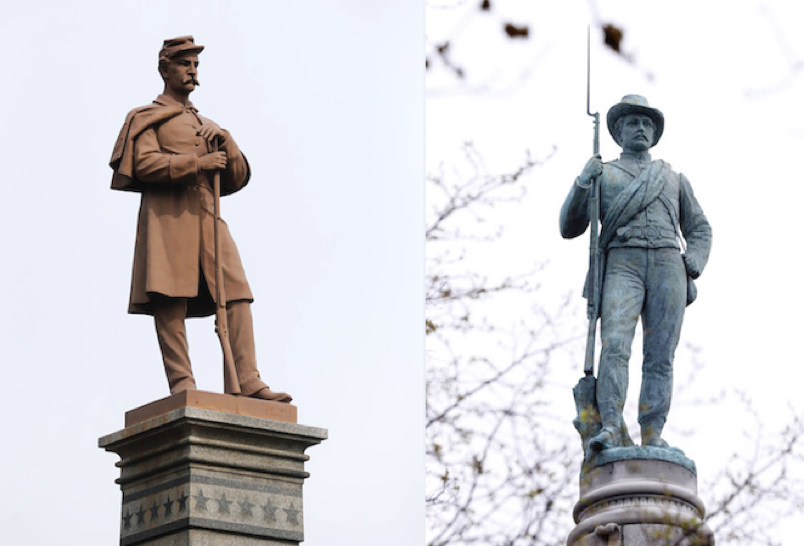SARATOGA SPRINGS, N.Y. (AP) — After the Civil War ended in April 1865, statues depicting Union and Confederate soldiers went up across the country, from New England squares to Southern courthouses. A century and a half later, these weathered “Silent Sentinels” still stand guard, rifles at the ready, gazing off in the distance.
For a war that pitted brother against brother, many of them bear a strong family resemblance.
Most of the statues were mass-produced by a handful of Northern companies that found a steady market selling to communities — North and South — eager to honor their fallen soldiers and surviving veterans.
“They’re not meant to represent one person or another,” said Sarah Beetham, an art historian who teaches at the University of Delaware and the Pennsylvania Academy of the Fine Arts. “This way, people could go and see in them their sons or fathers who had fought in the war.”
Known as the “Silent Sentinel,” ”Single Soldier” or similar names, he tops many of the thousands of Civil War monuments to be found in more than 30 states. Today, 150 years after the guns fell silent to end the nation’s bloodiest conflict, the ranks of the more than 3 million citizen soldiers who fought on both sides are represented by some of our most ubiquitous yet often overlooked public symbols.
“Before the Civil War, you would never have had an image of the common soldier to memorialize. You would have a general or a biblical figure,” said Earle Shettleworth, head historian for the state of Maine. “After the war, there was more of a democratic way of memorializing those who had participated.”
With untold thousands of war dead buried in graves on or near battlefields and encampments far from their homes, some communities in the North and South erected hometown monuments to the fallen even as the fighting raged. Most were stone obelisks placed in local cemeteries.
Within a couple of years after Gen. Robert E. Lee’s surrender at Appomattox, Virginia, more elaborate monuments were being commissioned from sculptors. By 1867, monuments featuring sculpted or cast metal soldier statues were dedicated in cemeteries in Cincinnati and Boston. The version depicting a single soldier at “parade rest” — hands gripping a musket at the end of the barrel, the stock resting on the ground — became the most popular way to honor the more than 2 million men who fought for the Union.
But commissioning a monument made of Italian marble or northern New England granite could cost tens of thousands of dollars, much too expensive for most small towns. Many turned to the northern foundries specializing in cast bronze or zinc statuary used to decorate cemetery markers. Firms such as the Monumental Bronze Co. of Bridgeport, Connecticut, did a brisk business selling soldier statues. A life-size parade rest model was listed in its sales catalog for $450, while the 8-foot-6-inch version sold for $750.
“It’s like going to Wal-Mart. It’s less expensive,” said Timothy S. Sedore, author of “An Illustrated Guide to Virginia’s Confederate Monuments.”
Because they had lost the war and were economically shattered, Southerners got a later start erecting monuments. By the time the 20th century arrived, they were making up for lost time, with hundreds of soldier statues installed across the South, typically outside county courthouses.
But old animosities died hard, and folks in the South didn’t usually publicize who was supplying the statues: mostly companies in Connecticut, Massachusetts and Ohio.
“The Southerners didn’t talk about that, buying from Yankees,” Beetham said.
Versions of the Silent Sentinel statue can be found from Amarillo, Texas, to Kennebunk, Maine. The Northern version features a Union soldier wearing a kepi and caped greatcoat, while his Southern counterpart typically wears the iconic slouch hat and bedroll strapped diagonally across his chest.
An accurate number of Civil War monuments is difficult to pin down. Beetham, who wrote her dissertation on post-Civil War citizen soldier monuments, estimates there are some 2,500 across the Northern states, with the Silent Sentinel version believed to account for as many as half of them. Estimates of Confederate monuments range between 500 and 1,000, including hundreds of the rebel version of the solitary soldier.
“In Georgia, there must be one in practically every county in every town square and cemetery, and it’s facing north, by the way,” said Ben Jones, a former Georgia congressman who played the role of Cooter on “The Dukes of Hazzard.”
Jones, the chief of heritage operations for the Sons of Confederate Veterans of the Civil War, said his group doesn’t have a definitive number. In Virginia, where Jones now lives, there are at least 360 Confederate monuments by Sedore’s count, including about 100 Silent Sentinels.
All those soldier monuments — North and South — are a collective symbol of the losses felt in virtually every community, Jones said.
“It represents the humanity, the family” and, he said, “the people who didn’t come back or who did come back worse for the wear.”
Copyright 2015 The Associated Press. All rights reserved. This material may not be published, broadcast, rewritten or redistributed.



